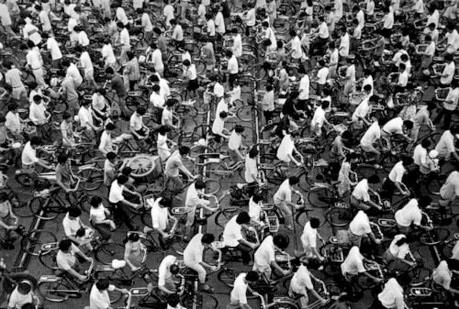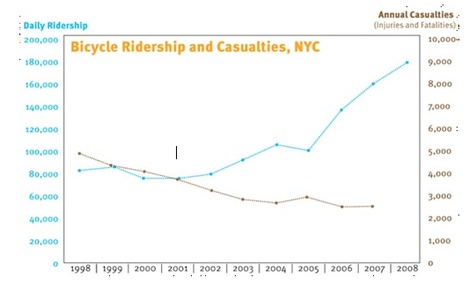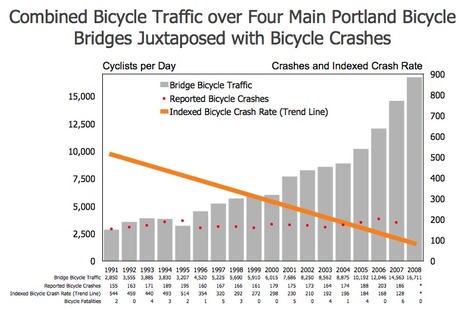
Two years ago I wrote For Bicylists, There is Safety in Numbers noting the work of Chris Rissel, who said "It appears that motorists adjust their behaviour in the presence of increasing numbers of people bicycling because they expect or experience more people cycling."
Last year we asked Is there "safety in numbers"? and quoted Peter Jacobson's 2003 study that concluded that "Where, or when, more people walk or bicycle, the less likely any of them are to be injured by motorists. There is safety in numbers."
Now cycling activist Elly Blue follows up on Grist with more recent data, and notes how the theory is catching on.

Ms. Blue explains why it works:
When there are a lot of bicyclists on the road, according to this theory, drivers take notice. They become more attentive, slow down, pass more cautiously, double-check their blind spots, expect the unexpected. They sense that the road has become a more complicated place, and adjust their behavior accordingly. As a result, the road becomes safer, presumably for everyone.
She concludes:
Safety in numbers will prove over time, I suspect, to be the first major theory based on objective data that can break down the double standard we all pedal under. Jacobsen's research calls into question the foundation of a system in which the convenience of driving is exalted above the basic safety and mobility of people walking and bicycling.

Cycleicious picks up the story and notes that the data in San Jose, California confirm the theory:
The number of cyclists on the road quadrupled in San Jose California between 2005 and 2008. You'd maybe expect a quadrupling in the number of cyclist fatalities as well, especially since all of those new cyclists are inexperienced and maybe tend to crash more. We see about two to six cyclist fatalities each year in all of Santa Clara County (which encompasses sevens time the area of the city of San Jose) In spite of the huge and visible increase in bikes in San Jose and environs.... there wasn't a corresponding increase in cyclist fatalities.
In Toronto, all the leading candidates for mayor are competing with each other to get rid of bike lanes and get the bikes out of the way, and the front runner says "My heart bleeds when someone gets killed, but it's their own fault at the end of the day."
All the data show that he is completely wrong, that it is not the cyclists own fault, and that the more cyclists there are, the safer everybody is.
From Treehugger.com
